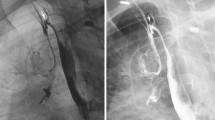Abstract
The purpose of this study was to evaluate use of the emergent barium swallow. One hundred thirty-four patients were referred for contrast esophagraphy directly from the emergency department of our hospital and were reviewed retrospectively. Clinical review at the time of the contrast examination revealed that 28 patients actually had features for which gastroduodenal or small bowel pathology was suspected. This left 106 patients with true esophageal studies. Fifty-six patients were suspected of having perforation. Contrast esophagram revealed esophageal disruption in six cases (11%). There were no false-negatives as determined by clinical follow-up. These six patients also had abnormal preliminary chest radiographs.
Fifty patients had swallowing difficulties. Of these, 19 were suspected of having an impacted foreign body. A foreign body was detected in four cases (20%), including one impacted at the pylorus. Twenty-seven patients had symptoms of dysphagia. An offending obstruction was found in 10 cases (35%), including four further cases of bolus impaction. Gastric or small bowel disease was identified in three cases. Four patients had odynophagia, and pathology was found in two of these cases (50%). Abnormal motility was noted in seven (14%) of these 50 patients.
The emergent contrast esophagram is of value when esophageal pathology is suspected. Perforation is an uncommon occurrence but has a recognized high morbidity and mortality if diagnosis and treatment are delayed. Esophagraphy is able to reliably diagnose or exclude this possibility. If the suspected pathology is not found, consideration should be given to alternative diagnoses, including dysmotility or a downstream lesion.
Similar content being viewed by others
References
Brewer LA, Carter R, Mulder GA, et al. Options in the management of perforations of the esophagus. Am J Surg 1986;152:62–7.
White RK, Morns DM. Diagnosis and management of esophageal perforations. Am Surg 1992;58:112–9.
Kim-Deobald J, Kozarek RA. Esophageal perforation: an 8-year review of multispecialty clinic’s experience. Am J Gastroenterol 1992;87:1112–9.
Ghahremani GG. Radiologic evaluation of suspected gastrointestinal perforations. Radiol Clin North Am 1993;31:1219–34.
Ghahremani GG, Turner MA, Port RB. Iatrogenic intubation injuries of the upper gastrointestinal tract in adults. Gastrointest Radiol 1980;5:1–10.
Klygis LM, Jutabha R, McCrohan MB, Vanagunas AD. Esophageal perforations masked by steroids. Abdom Imaging 1993;18:10–2.
Gollub MJ, Bains MS. Barium sulfate: a new (old) contrast agent for diagnosis of postoperative esophageal leaks. Radiology 1997;202:360–2.
Lovett I, Donchey S, Doust B, Branson J, Munro V. The effects of water soluble contrast agents on the respiratory tract. Australas Radiol 1989;33:124–7.
Brick SH, Caroline DF, Lev-Toaff AS, Friedman AC, Grumbach K, Radecki PD. Esophageal disruption: evaluation with Iohexol esophagraphy. Radiology 1988;169:141–3.
Maglinte DDT, Chernish SM, Kelvin FM, et al. Esophageal foreign bodies: review and recommendation. Emerg Radiol 1995;2:151–7.
Levine MS. Question and answer. AJR Am J Roentgenol 1995;165:480–1.
MacPherson RI, Hill JG, Othersen HB, Tagge EP, Smith CD. Esophageal foregin bodies in children: diagnosis, treatment, and complications. AJR Am J Roentgenol 1996;166:919–24.
Harned RK II, Strain J, Hay TC, Douglas MR. Esophageal foreign bodies: safety and efficacy of Foley catheter extraction of coins. AJR Am J Roentgenol 1997;168:443–6.
Low VHS, Rubesin SE. Contrast evaluation of the pharynx and esophagus. Radiol Clin North Am 1993;31:1265–91.
Levine MS, Kressel HY, Laufer I, et al. The tube esophagram: a technique for obtaining a detailed double-contrast examination of the esophagus. AJR Am J Roentgenol 1984;142:293–8.
Author information
Authors and Affiliations
Rights and permissions
About this article
Cite this article
Sitarik, K.M., Low, V.H.S. Utilization of the emergent barium swallow. Emergency Radiology 5, 385–390 (1998). https://doi.org/10.1007/BF02749185
Issue Date:
DOI: https://doi.org/10.1007/BF02749185




